Analytical Modelling of Helical Pile Foundation Systems Report
VerifiedAdded on 2021/05/31
|10
|2972
|130
Report
AI Summary
This report provides an in-depth analysis of helical pile foundation systems, focusing on analytical modeling for renewable energy applications. It explores the installation process, highlighting advantages such as rapid installation, reduced noise and vibration, and suitability for restricted areas. The report delves into the impact of installation on soil strength, pore pressure dissipation, and the resulting increase in pile bearing capacity. It examines the influence of helical plate number and spacing on stiffness and capacity, emphasizing the importance of the spacing ratio in design. Furthermore, the report discusses the use of helical piles in various applications, including structures subjected to lateral and compressive loading, and their advantages over traditional piling methods, such as reusability and cost-effectiveness. The research also covers the axial capacities of helical piles and the analytical methods used to predict them, including the cylindrical shear method and the individual bearing method. Finally, the report highlights the growing interest and global applications of helical piles, including their use in marine environments and as foundations for wind turbines, emphasizing their ability to support heavy loads and provide resistance to axial and tensile forces.
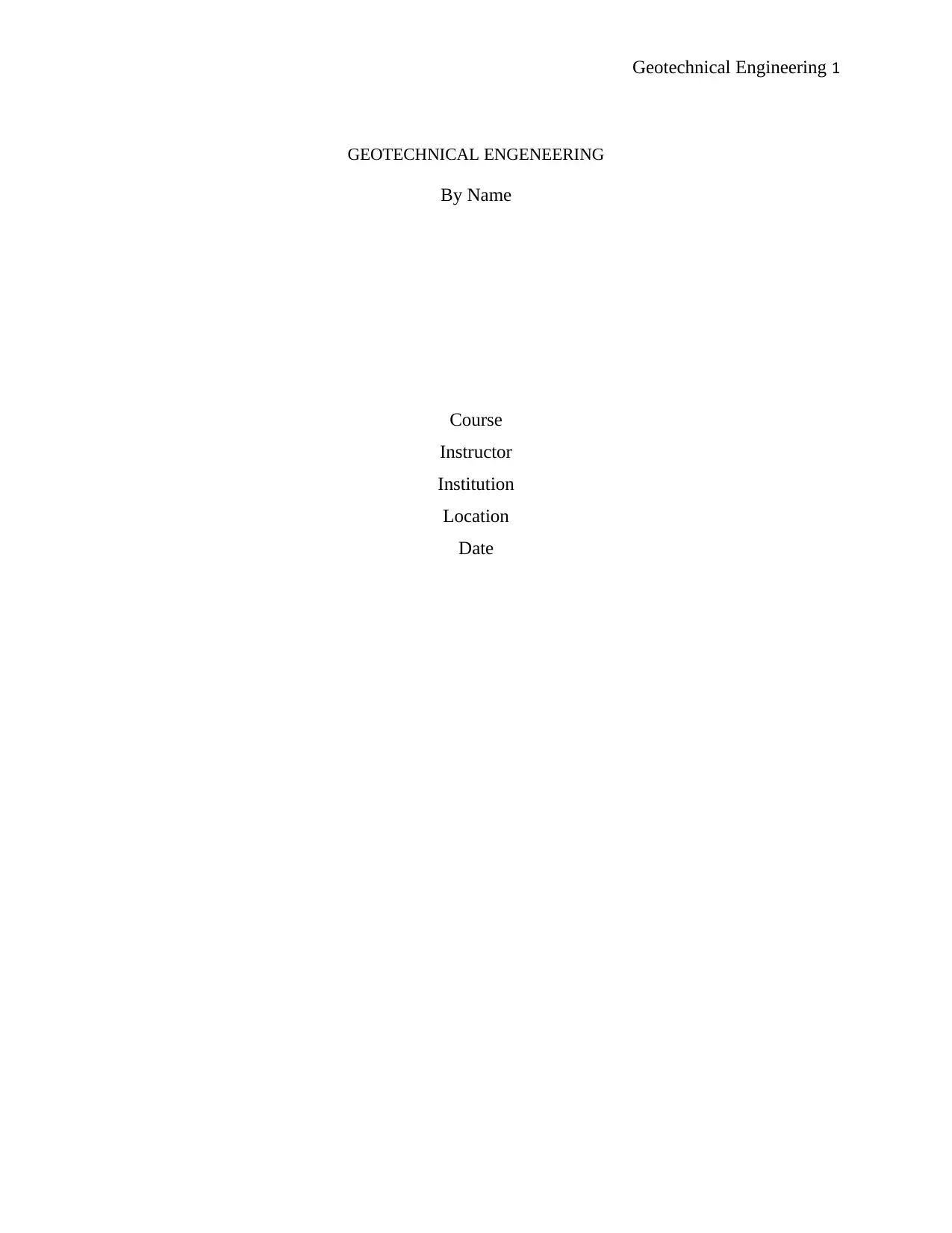
Geotechnical Engineering 1
GEOTECHNICAL ENGENEERING
By Name
Course
Instructor
Institution
Location
Date
GEOTECHNICAL ENGENEERING
By Name
Course
Instructor
Institution
Location
Date
Secure Best Marks with AI Grader
Need help grading? Try our AI Grader for instant feedback on your assignments.
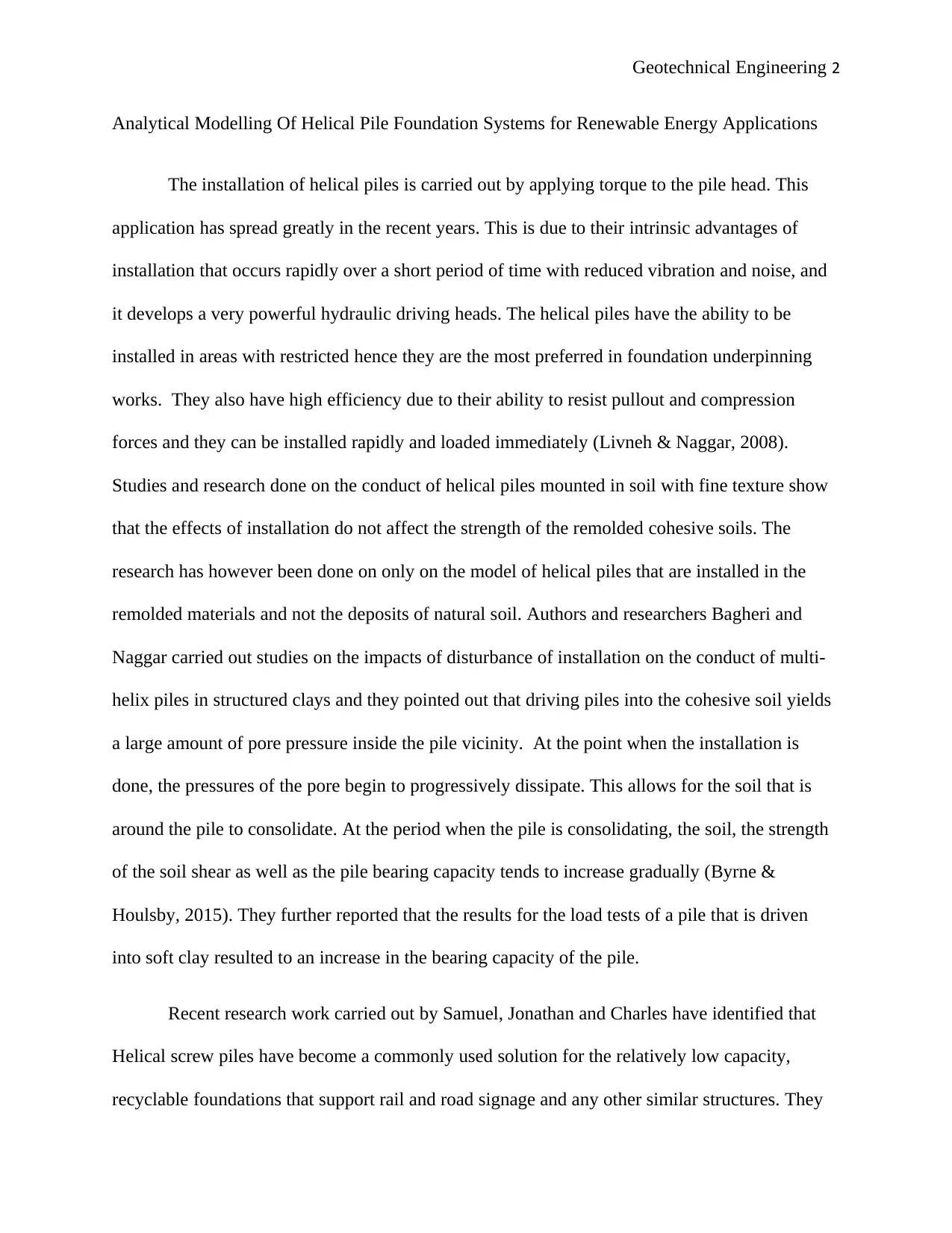
Geotechnical Engineering 2
Analytical Modelling Of Helical Pile Foundation Systems for Renewable Energy Applications
The installation of helical piles is carried out by applying torque to the pile head. This
application has spread greatly in the recent years. This is due to their intrinsic advantages of
installation that occurs rapidly over a short period of time with reduced vibration and noise, and
it develops a very powerful hydraulic driving heads. The helical piles have the ability to be
installed in areas with restricted hence they are the most preferred in foundation underpinning
works. They also have high efficiency due to their ability to resist pullout and compression
forces and they can be installed rapidly and loaded immediately (Livneh & Naggar, 2008).
Studies and research done on the conduct of helical piles mounted in soil with fine texture show
that the effects of installation do not affect the strength of the remolded cohesive soils. The
research has however been done on only on the model of helical piles that are installed in the
remolded materials and not the deposits of natural soil. Authors and researchers Bagheri and
Naggar carried out studies on the impacts of disturbance of installation on the conduct of multi-
helix piles in structured clays and they pointed out that driving piles into the cohesive soil yields
a large amount of pore pressure inside the pile vicinity. At the point when the installation is
done, the pressures of the pore begin to progressively dissipate. This allows for the soil that is
around the pile to consolidate. At the period when the pile is consolidating, the soil, the strength
of the soil shear as well as the pile bearing capacity tends to increase gradually (Byrne &
Houlsby, 2015). They further reported that the results for the load tests of a pile that is driven
into soft clay resulted to an increase in the bearing capacity of the pile.
Recent research work carried out by Samuel, Jonathan and Charles have identified that
Helical screw piles have become a commonly used solution for the relatively low capacity,
recyclable foundations that support rail and road signage and any other similar structures. They
Analytical Modelling Of Helical Pile Foundation Systems for Renewable Energy Applications
The installation of helical piles is carried out by applying torque to the pile head. This
application has spread greatly in the recent years. This is due to their intrinsic advantages of
installation that occurs rapidly over a short period of time with reduced vibration and noise, and
it develops a very powerful hydraulic driving heads. The helical piles have the ability to be
installed in areas with restricted hence they are the most preferred in foundation underpinning
works. They also have high efficiency due to their ability to resist pullout and compression
forces and they can be installed rapidly and loaded immediately (Livneh & Naggar, 2008).
Studies and research done on the conduct of helical piles mounted in soil with fine texture show
that the effects of installation do not affect the strength of the remolded cohesive soils. The
research has however been done on only on the model of helical piles that are installed in the
remolded materials and not the deposits of natural soil. Authors and researchers Bagheri and
Naggar carried out studies on the impacts of disturbance of installation on the conduct of multi-
helix piles in structured clays and they pointed out that driving piles into the cohesive soil yields
a large amount of pore pressure inside the pile vicinity. At the point when the installation is
done, the pressures of the pore begin to progressively dissipate. This allows for the soil that is
around the pile to consolidate. At the period when the pile is consolidating, the soil, the strength
of the soil shear as well as the pile bearing capacity tends to increase gradually (Byrne &
Houlsby, 2015). They further reported that the results for the load tests of a pile that is driven
into soft clay resulted to an increase in the bearing capacity of the pile.
Recent research work carried out by Samuel, Jonathan and Charles have identified that
Helical screw piles have become a commonly used solution for the relatively low capacity,
recyclable foundations that support rail and road signage and any other similar structures. They
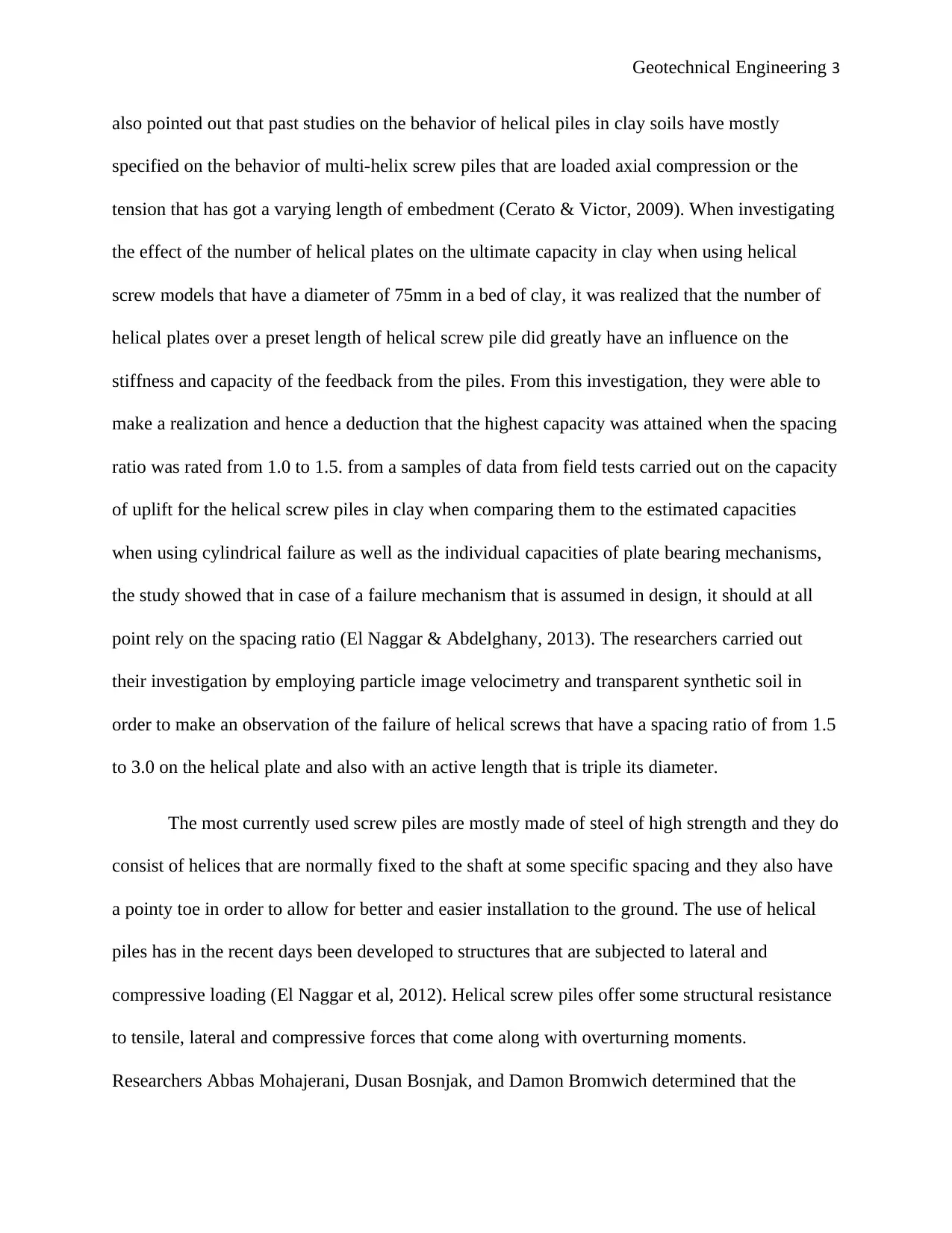
Geotechnical Engineering 3
also pointed out that past studies on the behavior of helical piles in clay soils have mostly
specified on the behavior of multi-helix screw piles that are loaded axial compression or the
tension that has got a varying length of embedment (Cerato & Victor, 2009). When investigating
the effect of the number of helical plates on the ultimate capacity in clay when using helical
screw models that have a diameter of 75mm in a bed of clay, it was realized that the number of
helical plates over a preset length of helical screw pile did greatly have an influence on the
stiffness and capacity of the feedback from the piles. From this investigation, they were able to
make a realization and hence a deduction that the highest capacity was attained when the spacing
ratio was rated from 1.0 to 1.5. from a samples of data from field tests carried out on the capacity
of uplift for the helical screw piles in clay when comparing them to the estimated capacities
when using cylindrical failure as well as the individual capacities of plate bearing mechanisms,
the study showed that in case of a failure mechanism that is assumed in design, it should at all
point rely on the spacing ratio (El Naggar & Abdelghany, 2013). The researchers carried out
their investigation by employing particle image velocimetry and transparent synthetic soil in
order to make an observation of the failure of helical screws that have a spacing ratio of from 1.5
to 3.0 on the helical plate and also with an active length that is triple its diameter.
The most currently used screw piles are mostly made of steel of high strength and they do
consist of helices that are normally fixed to the shaft at some specific spacing and they also have
a pointy toe in order to allow for better and easier installation to the ground. The use of helical
piles has in the recent days been developed to structures that are subjected to lateral and
compressive loading (El Naggar et al, 2012). Helical screw piles offer some structural resistance
to tensile, lateral and compressive forces that come along with overturning moments.
Researchers Abbas Mohajerani, Dusan Bosnjak, and Damon Bromwich determined that the
also pointed out that past studies on the behavior of helical piles in clay soils have mostly
specified on the behavior of multi-helix screw piles that are loaded axial compression or the
tension that has got a varying length of embedment (Cerato & Victor, 2009). When investigating
the effect of the number of helical plates on the ultimate capacity in clay when using helical
screw models that have a diameter of 75mm in a bed of clay, it was realized that the number of
helical plates over a preset length of helical screw pile did greatly have an influence on the
stiffness and capacity of the feedback from the piles. From this investigation, they were able to
make a realization and hence a deduction that the highest capacity was attained when the spacing
ratio was rated from 1.0 to 1.5. from a samples of data from field tests carried out on the capacity
of uplift for the helical screw piles in clay when comparing them to the estimated capacities
when using cylindrical failure as well as the individual capacities of plate bearing mechanisms,
the study showed that in case of a failure mechanism that is assumed in design, it should at all
point rely on the spacing ratio (El Naggar & Abdelghany, 2013). The researchers carried out
their investigation by employing particle image velocimetry and transparent synthetic soil in
order to make an observation of the failure of helical screws that have a spacing ratio of from 1.5
to 3.0 on the helical plate and also with an active length that is triple its diameter.
The most currently used screw piles are mostly made of steel of high strength and they do
consist of helices that are normally fixed to the shaft at some specific spacing and they also have
a pointy toe in order to allow for better and easier installation to the ground. The use of helical
piles has in the recent days been developed to structures that are subjected to lateral and
compressive loading (El Naggar et al, 2012). Helical screw piles offer some structural resistance
to tensile, lateral and compressive forces that come along with overturning moments.
Researchers Abbas Mohajerani, Dusan Bosnjak, and Damon Bromwich determined that the
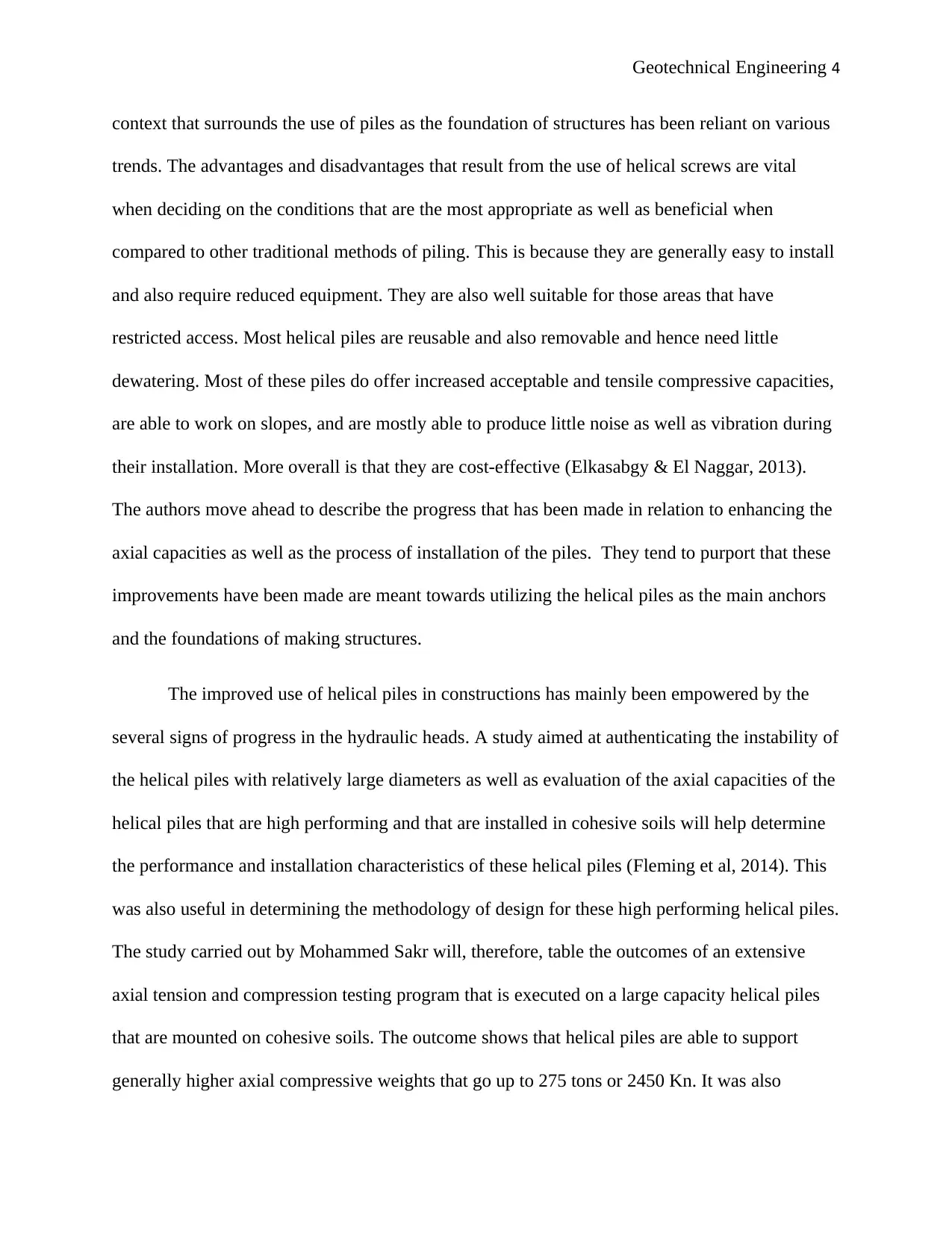
Geotechnical Engineering 4
context that surrounds the use of piles as the foundation of structures has been reliant on various
trends. The advantages and disadvantages that result from the use of helical screws are vital
when deciding on the conditions that are the most appropriate as well as beneficial when
compared to other traditional methods of piling. This is because they are generally easy to install
and also require reduced equipment. They are also well suitable for those areas that have
restricted access. Most helical piles are reusable and also removable and hence need little
dewatering. Most of these piles do offer increased acceptable and tensile compressive capacities,
are able to work on slopes, and are mostly able to produce little noise as well as vibration during
their installation. More overall is that they are cost-effective (Elkasabgy & El Naggar, 2013).
The authors move ahead to describe the progress that has been made in relation to enhancing the
axial capacities as well as the process of installation of the piles. They tend to purport that these
improvements have been made are meant towards utilizing the helical piles as the main anchors
and the foundations of making structures.
The improved use of helical piles in constructions has mainly been empowered by the
several signs of progress in the hydraulic heads. A study aimed at authenticating the instability of
the helical piles with relatively large diameters as well as evaluation of the axial capacities of the
helical piles that are high performing and that are installed in cohesive soils will help determine
the performance and installation characteristics of these helical piles (Fleming et al, 2014). This
was also useful in determining the methodology of design for these high performing helical piles.
The study carried out by Mohammed Sakr will, therefore, table the outcomes of an extensive
axial tension and compression testing program that is executed on a large capacity helical piles
that are mounted on cohesive soils. The outcome shows that helical piles are able to support
generally higher axial compressive weights that go up to 275 tons or 2450 Kn. It was also
context that surrounds the use of piles as the foundation of structures has been reliant on various
trends. The advantages and disadvantages that result from the use of helical screws are vital
when deciding on the conditions that are the most appropriate as well as beneficial when
compared to other traditional methods of piling. This is because they are generally easy to install
and also require reduced equipment. They are also well suitable for those areas that have
restricted access. Most helical piles are reusable and also removable and hence need little
dewatering. Most of these piles do offer increased acceptable and tensile compressive capacities,
are able to work on slopes, and are mostly able to produce little noise as well as vibration during
their installation. More overall is that they are cost-effective (Elkasabgy & El Naggar, 2013).
The authors move ahead to describe the progress that has been made in relation to enhancing the
axial capacities as well as the process of installation of the piles. They tend to purport that these
improvements have been made are meant towards utilizing the helical piles as the main anchors
and the foundations of making structures.
The improved use of helical piles in constructions has mainly been empowered by the
several signs of progress in the hydraulic heads. A study aimed at authenticating the instability of
the helical piles with relatively large diameters as well as evaluation of the axial capacities of the
helical piles that are high performing and that are installed in cohesive soils will help determine
the performance and installation characteristics of these helical piles (Fleming et al, 2014). This
was also useful in determining the methodology of design for these high performing helical piles.
The study carried out by Mohammed Sakr will, therefore, table the outcomes of an extensive
axial tension and compression testing program that is executed on a large capacity helical piles
that are mounted on cohesive soils. The outcome shows that helical piles are able to support
generally higher axial compressive weights that go up to 275 tons or 2450 Kn. It was also
Secure Best Marks with AI Grader
Need help grading? Try our AI Grader for instant feedback on your assignments.
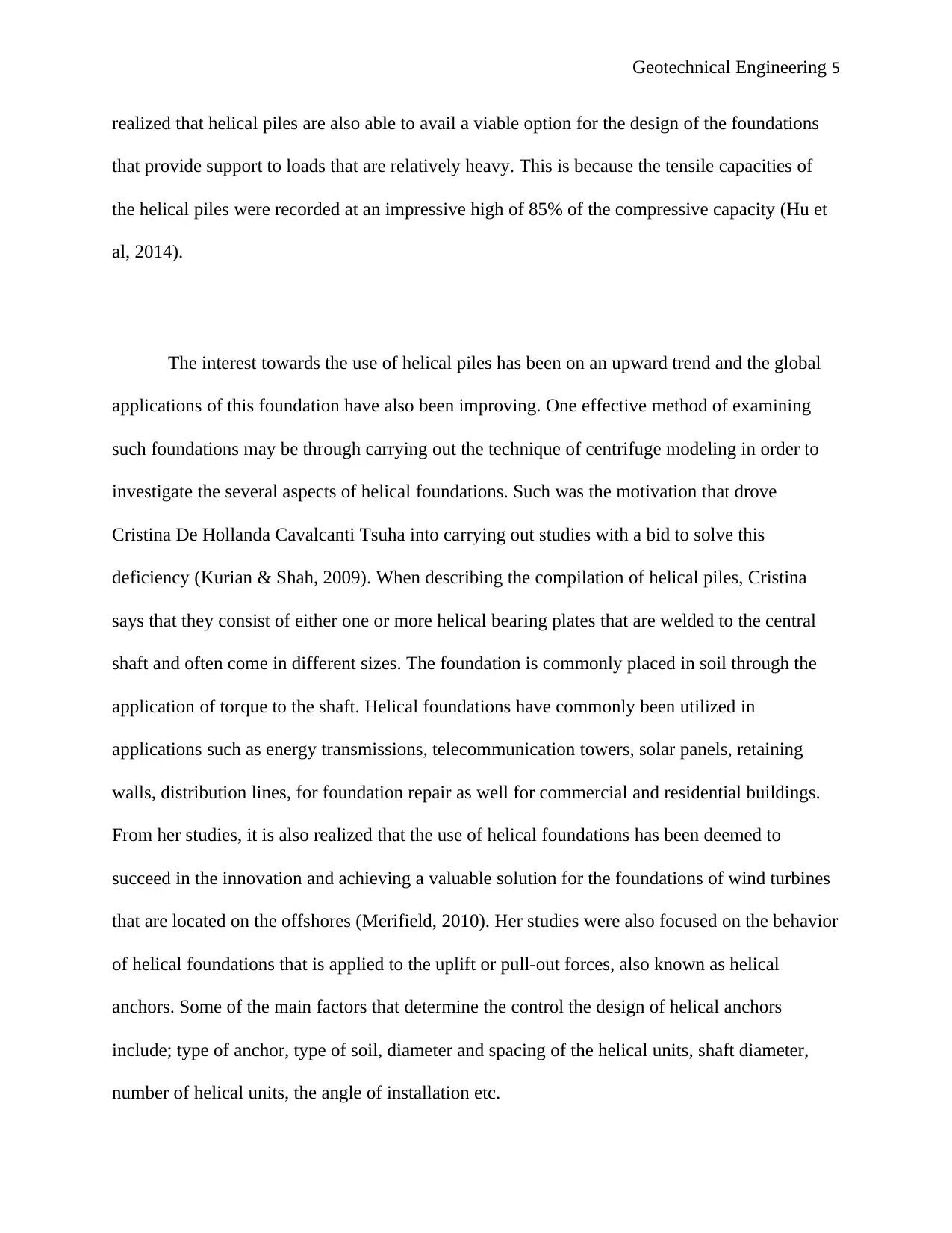
Geotechnical Engineering 5
realized that helical piles are also able to avail a viable option for the design of the foundations
that provide support to loads that are relatively heavy. This is because the tensile capacities of
the helical piles were recorded at an impressive high of 85% of the compressive capacity (Hu et
al, 2014).
The interest towards the use of helical piles has been on an upward trend and the global
applications of this foundation have also been improving. One effective method of examining
such foundations may be through carrying out the technique of centrifuge modeling in order to
investigate the several aspects of helical foundations. Such was the motivation that drove
Cristina De Hollanda Cavalcanti Tsuha into carrying out studies with a bid to solve this
deficiency (Kurian & Shah, 2009). When describing the compilation of helical piles, Cristina
says that they consist of either one or more helical bearing plates that are welded to the central
shaft and often come in different sizes. The foundation is commonly placed in soil through the
application of torque to the shaft. Helical foundations have commonly been utilized in
applications such as energy transmissions, telecommunication towers, solar panels, retaining
walls, distribution lines, for foundation repair as well for commercial and residential buildings.
From her studies, it is also realized that the use of helical foundations has been deemed to
succeed in the innovation and achieving a valuable solution for the foundations of wind turbines
that are located on the offshores (Merifield, 2010). Her studies were also focused on the behavior
of helical foundations that is applied to the uplift or pull-out forces, also known as helical
anchors. Some of the main factors that determine the control the design of helical anchors
include; type of anchor, type of soil, diameter and spacing of the helical units, shaft diameter,
number of helical units, the angle of installation etc.
realized that helical piles are also able to avail a viable option for the design of the foundations
that provide support to loads that are relatively heavy. This is because the tensile capacities of
the helical piles were recorded at an impressive high of 85% of the compressive capacity (Hu et
al, 2014).
The interest towards the use of helical piles has been on an upward trend and the global
applications of this foundation have also been improving. One effective method of examining
such foundations may be through carrying out the technique of centrifuge modeling in order to
investigate the several aspects of helical foundations. Such was the motivation that drove
Cristina De Hollanda Cavalcanti Tsuha into carrying out studies with a bid to solve this
deficiency (Kurian & Shah, 2009). When describing the compilation of helical piles, Cristina
says that they consist of either one or more helical bearing plates that are welded to the central
shaft and often come in different sizes. The foundation is commonly placed in soil through the
application of torque to the shaft. Helical foundations have commonly been utilized in
applications such as energy transmissions, telecommunication towers, solar panels, retaining
walls, distribution lines, for foundation repair as well for commercial and residential buildings.
From her studies, it is also realized that the use of helical foundations has been deemed to
succeed in the innovation and achieving a valuable solution for the foundations of wind turbines
that are located on the offshores (Merifield, 2010). Her studies were also focused on the behavior
of helical foundations that is applied to the uplift or pull-out forces, also known as helical
anchors. Some of the main factors that determine the control the design of helical anchors
include; type of anchor, type of soil, diameter and spacing of the helical units, shaft diameter,
number of helical units, the angle of installation etc.
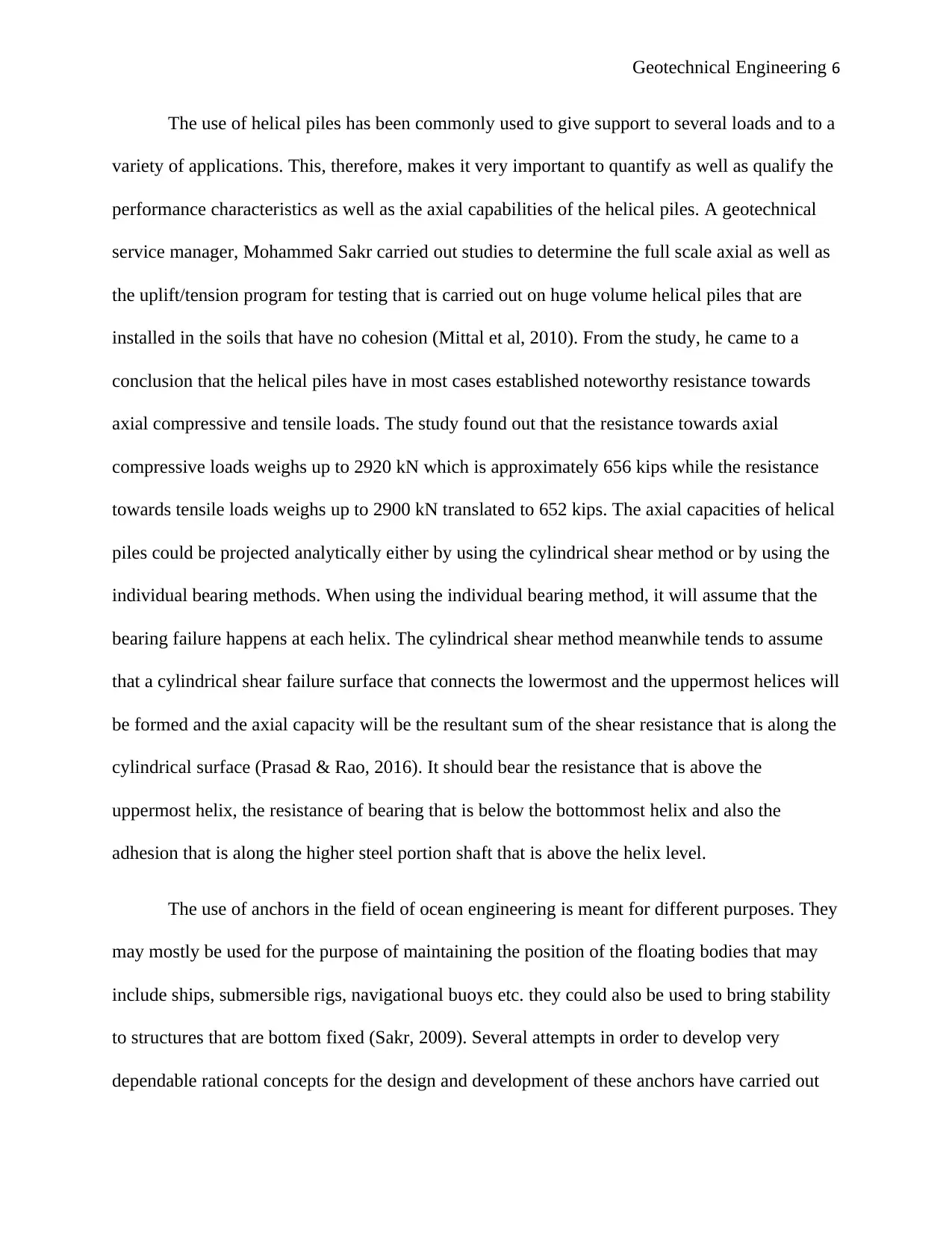
Geotechnical Engineering 6
The use of helical piles has been commonly used to give support to several loads and to a
variety of applications. This, therefore, makes it very important to quantify as well as qualify the
performance characteristics as well as the axial capabilities of the helical piles. A geotechnical
service manager, Mohammed Sakr carried out studies to determine the full scale axial as well as
the uplift/tension program for testing that is carried out on huge volume helical piles that are
installed in the soils that have no cohesion (Mittal et al, 2010). From the study, he came to a
conclusion that the helical piles have in most cases established noteworthy resistance towards
axial compressive and tensile loads. The study found out that the resistance towards axial
compressive loads weighs up to 2920 kN which is approximately 656 kips while the resistance
towards tensile loads weighs up to 2900 kN translated to 652 kips. The axial capacities of helical
piles could be projected analytically either by using the cylindrical shear method or by using the
individual bearing methods. When using the individual bearing method, it will assume that the
bearing failure happens at each helix. The cylindrical shear method meanwhile tends to assume
that a cylindrical shear failure surface that connects the lowermost and the uppermost helices will
be formed and the axial capacity will be the resultant sum of the shear resistance that is along the
cylindrical surface (Prasad & Rao, 2016). It should bear the resistance that is above the
uppermost helix, the resistance of bearing that is below the bottommost helix and also the
adhesion that is along the higher steel portion shaft that is above the helix level.
The use of anchors in the field of ocean engineering is meant for different purposes. They
may mostly be used for the purpose of maintaining the position of the floating bodies that may
include ships, submersible rigs, navigational buoys etc. they could also be used to bring stability
to structures that are bottom fixed (Sakr, 2009). Several attempts in order to develop very
dependable rational concepts for the design and development of these anchors have carried out
The use of helical piles has been commonly used to give support to several loads and to a
variety of applications. This, therefore, makes it very important to quantify as well as qualify the
performance characteristics as well as the axial capabilities of the helical piles. A geotechnical
service manager, Mohammed Sakr carried out studies to determine the full scale axial as well as
the uplift/tension program for testing that is carried out on huge volume helical piles that are
installed in the soils that have no cohesion (Mittal et al, 2010). From the study, he came to a
conclusion that the helical piles have in most cases established noteworthy resistance towards
axial compressive and tensile loads. The study found out that the resistance towards axial
compressive loads weighs up to 2920 kN which is approximately 656 kips while the resistance
towards tensile loads weighs up to 2900 kN translated to 652 kips. The axial capacities of helical
piles could be projected analytically either by using the cylindrical shear method or by using the
individual bearing methods. When using the individual bearing method, it will assume that the
bearing failure happens at each helix. The cylindrical shear method meanwhile tends to assume
that a cylindrical shear failure surface that connects the lowermost and the uppermost helices will
be formed and the axial capacity will be the resultant sum of the shear resistance that is along the
cylindrical surface (Prasad & Rao, 2016). It should bear the resistance that is above the
uppermost helix, the resistance of bearing that is below the bottommost helix and also the
adhesion that is along the higher steel portion shaft that is above the helix level.
The use of anchors in the field of ocean engineering is meant for different purposes. They
may mostly be used for the purpose of maintaining the position of the floating bodies that may
include ships, submersible rigs, navigational buoys etc. they could also be used to bring stability
to structures that are bottom fixed (Sakr, 2009). Several attempts in order to develop very
dependable rational concepts for the design and development of these anchors have carried out
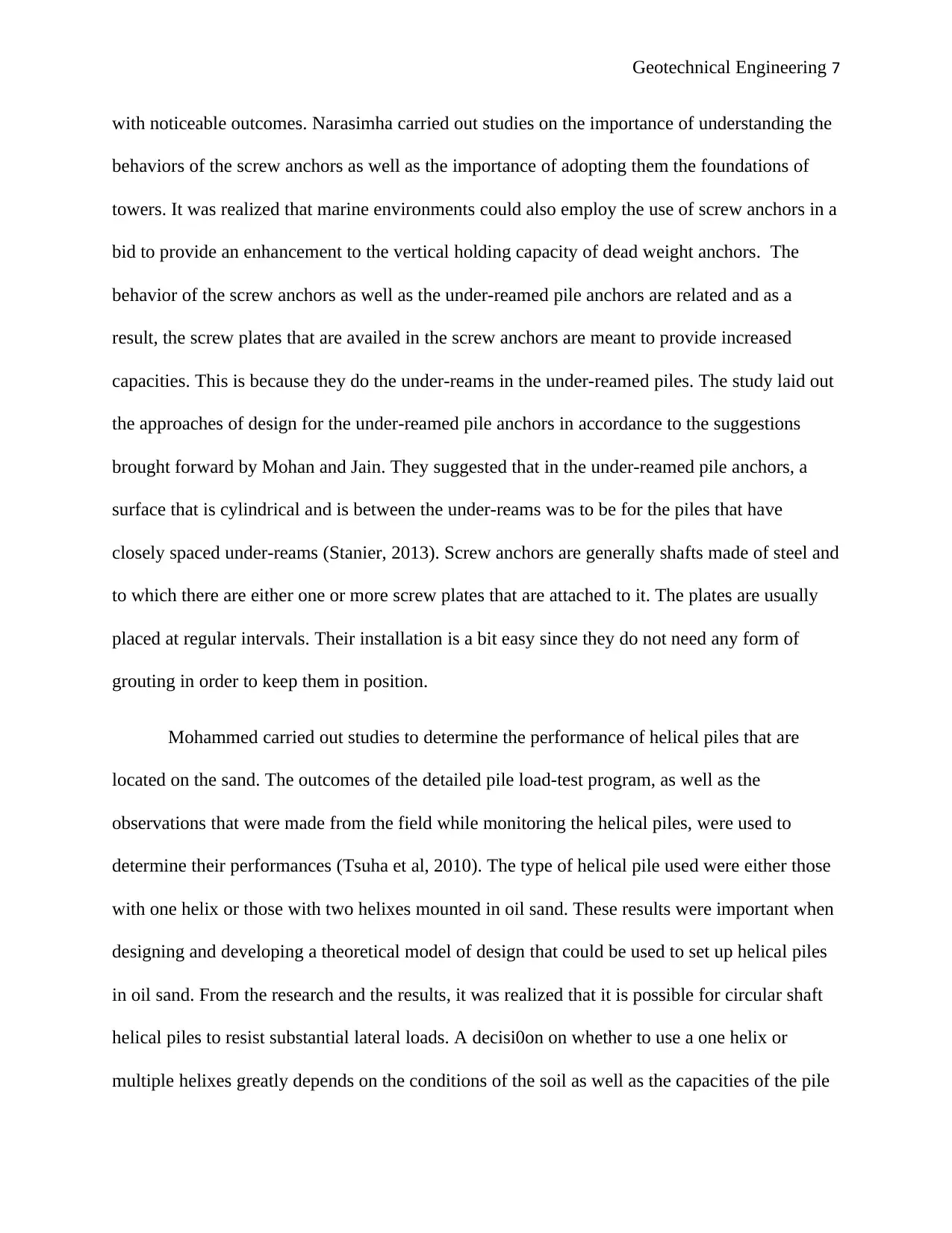
Geotechnical Engineering 7
with noticeable outcomes. Narasimha carried out studies on the importance of understanding the
behaviors of the screw anchors as well as the importance of adopting them the foundations of
towers. It was realized that marine environments could also employ the use of screw anchors in a
bid to provide an enhancement to the vertical holding capacity of dead weight anchors. The
behavior of the screw anchors as well as the under-reamed pile anchors are related and as a
result, the screw plates that are availed in the screw anchors are meant to provide increased
capacities. This is because they do the under-reams in the under-reamed piles. The study laid out
the approaches of design for the under-reamed pile anchors in accordance to the suggestions
brought forward by Mohan and Jain. They suggested that in the under-reamed pile anchors, a
surface that is cylindrical and is between the under-reams was to be for the piles that have
closely spaced under-reams (Stanier, 2013). Screw anchors are generally shafts made of steel and
to which there are either one or more screw plates that are attached to it. The plates are usually
placed at regular intervals. Their installation is a bit easy since they do not need any form of
grouting in order to keep them in position.
Mohammed carried out studies to determine the performance of helical piles that are
located on the sand. The outcomes of the detailed pile load-test program, as well as the
observations that were made from the field while monitoring the helical piles, were used to
determine their performances (Tsuha et al, 2010). The type of helical pile used were either those
with one helix or those with two helixes mounted in oil sand. These results were important when
designing and developing a theoretical model of design that could be used to set up helical piles
in oil sand. From the research and the results, it was realized that it is possible for circular shaft
helical piles to resist substantial lateral loads. A decisi0on on whether to use a one helix or
multiple helixes greatly depends on the conditions of the soil as well as the capacities of the pile
with noticeable outcomes. Narasimha carried out studies on the importance of understanding the
behaviors of the screw anchors as well as the importance of adopting them the foundations of
towers. It was realized that marine environments could also employ the use of screw anchors in a
bid to provide an enhancement to the vertical holding capacity of dead weight anchors. The
behavior of the screw anchors as well as the under-reamed pile anchors are related and as a
result, the screw plates that are availed in the screw anchors are meant to provide increased
capacities. This is because they do the under-reams in the under-reamed piles. The study laid out
the approaches of design for the under-reamed pile anchors in accordance to the suggestions
brought forward by Mohan and Jain. They suggested that in the under-reamed pile anchors, a
surface that is cylindrical and is between the under-reams was to be for the piles that have
closely spaced under-reams (Stanier, 2013). Screw anchors are generally shafts made of steel and
to which there are either one or more screw plates that are attached to it. The plates are usually
placed at regular intervals. Their installation is a bit easy since they do not need any form of
grouting in order to keep them in position.
Mohammed carried out studies to determine the performance of helical piles that are
located on the sand. The outcomes of the detailed pile load-test program, as well as the
observations that were made from the field while monitoring the helical piles, were used to
determine their performances (Tsuha et al, 2010). The type of helical pile used were either those
with one helix or those with two helixes mounted in oil sand. These results were important when
designing and developing a theoretical model of design that could be used to set up helical piles
in oil sand. From the research and the results, it was realized that it is possible for circular shaft
helical piles to resist substantial lateral loads. A decisi0on on whether to use a one helix or
multiple helixes greatly depends on the conditions of the soil as well as the capacities of the pile
Paraphrase This Document
Need a fresh take? Get an instant paraphrase of this document with our AI Paraphraser
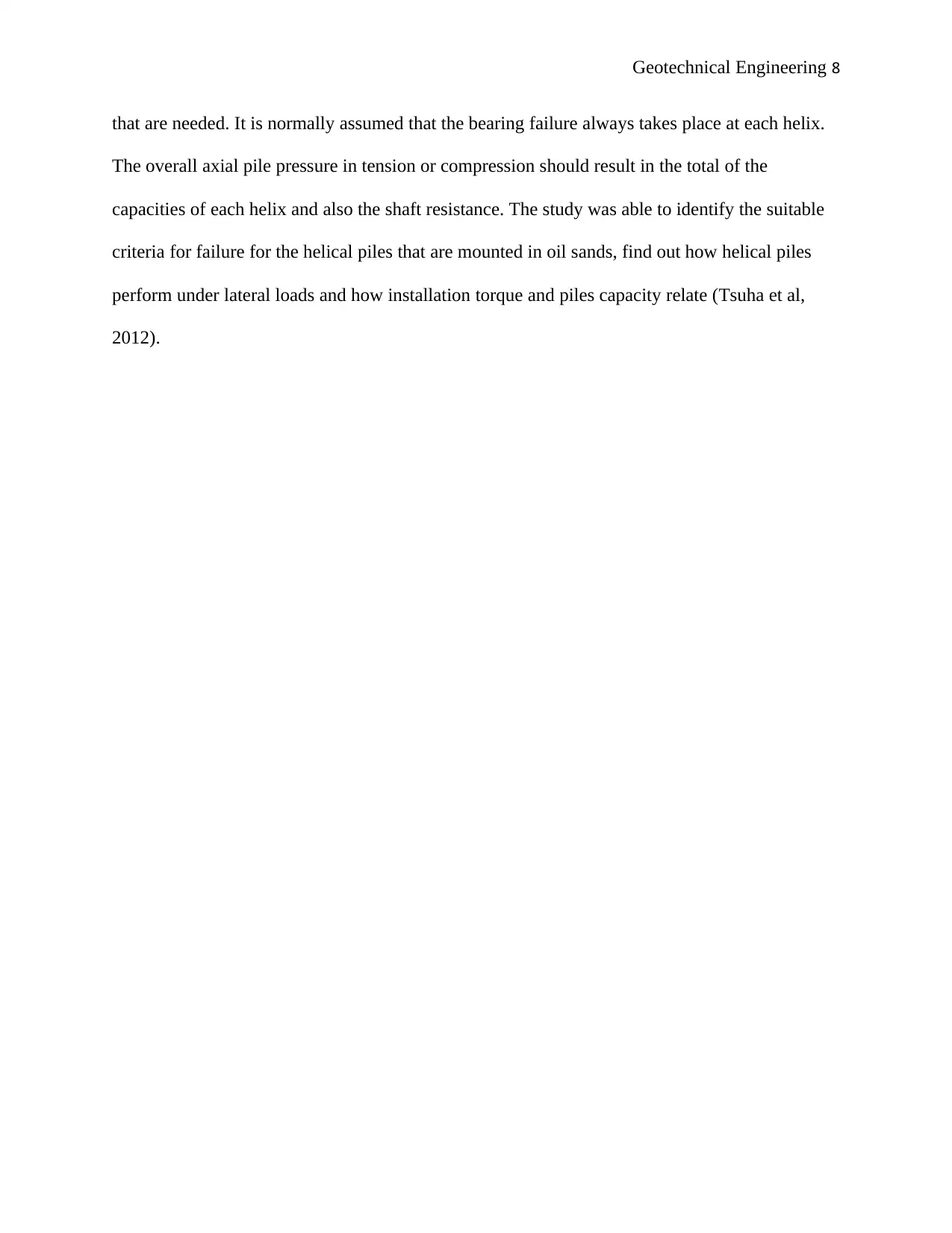
Geotechnical Engineering 8
that are needed. It is normally assumed that the bearing failure always takes place at each helix.
The overall axial pile pressure in tension or compression should result in the total of the
capacities of each helix and also the shaft resistance. The study was able to identify the suitable
criteria for failure for the helical piles that are mounted in oil sands, find out how helical piles
perform under lateral loads and how installation torque and piles capacity relate (Tsuha et al,
2012).
that are needed. It is normally assumed that the bearing failure always takes place at each helix.
The overall axial pile pressure in tension or compression should result in the total of the
capacities of each helix and also the shaft resistance. The study was able to identify the suitable
criteria for failure for the helical piles that are mounted in oil sands, find out how helical piles
perform under lateral loads and how installation torque and piles capacity relate (Tsuha et al,
2012).
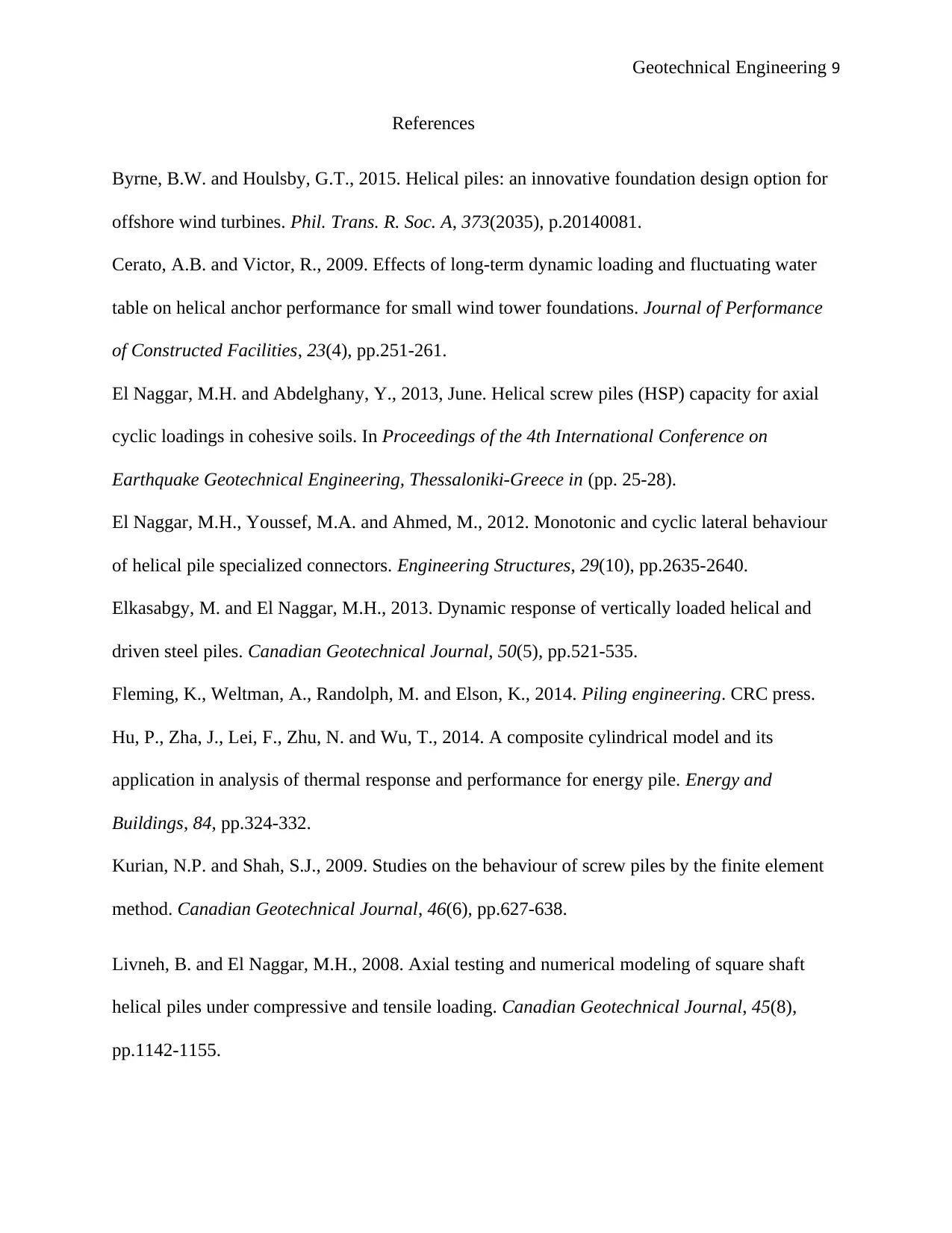
Geotechnical Engineering 9
References
Byrne, B.W. and Houlsby, G.T., 2015. Helical piles: an innovative foundation design option for
offshore wind turbines. Phil. Trans. R. Soc. A, 373(2035), p.20140081.
Cerato, A.B. and Victor, R., 2009. Effects of long-term dynamic loading and fluctuating water
table on helical anchor performance for small wind tower foundations. Journal of Performance
of Constructed Facilities, 23(4), pp.251-261.
El Naggar, M.H. and Abdelghany, Y., 2013, June. Helical screw piles (HSP) capacity for axial
cyclic loadings in cohesive soils. In Proceedings of the 4th International Conference on
Earthquake Geotechnical Engineering, Thessaloniki-Greece in (pp. 25-28).
El Naggar, M.H., Youssef, M.A. and Ahmed, M., 2012. Monotonic and cyclic lateral behaviour
of helical pile specialized connectors. Engineering Structures, 29(10), pp.2635-2640.
Elkasabgy, M. and El Naggar, M.H., 2013. Dynamic response of vertically loaded helical and
driven steel piles. Canadian Geotechnical Journal, 50(5), pp.521-535.
Fleming, K., Weltman, A., Randolph, M. and Elson, K., 2014. Piling engineering. CRC press.
Hu, P., Zha, J., Lei, F., Zhu, N. and Wu, T., 2014. A composite cylindrical model and its
application in analysis of thermal response and performance for energy pile. Energy and
Buildings, 84, pp.324-332.
Kurian, N.P. and Shah, S.J., 2009. Studies on the behaviour of screw piles by the finite element
method. Canadian Geotechnical Journal, 46(6), pp.627-638.
Livneh, B. and El Naggar, M.H., 2008. Axial testing and numerical modeling of square shaft
helical piles under compressive and tensile loading. Canadian Geotechnical Journal, 45(8),
pp.1142-1155.
References
Byrne, B.W. and Houlsby, G.T., 2015. Helical piles: an innovative foundation design option for
offshore wind turbines. Phil. Trans. R. Soc. A, 373(2035), p.20140081.
Cerato, A.B. and Victor, R., 2009. Effects of long-term dynamic loading and fluctuating water
table on helical anchor performance for small wind tower foundations. Journal of Performance
of Constructed Facilities, 23(4), pp.251-261.
El Naggar, M.H. and Abdelghany, Y., 2013, June. Helical screw piles (HSP) capacity for axial
cyclic loadings in cohesive soils. In Proceedings of the 4th International Conference on
Earthquake Geotechnical Engineering, Thessaloniki-Greece in (pp. 25-28).
El Naggar, M.H., Youssef, M.A. and Ahmed, M., 2012. Monotonic and cyclic lateral behaviour
of helical pile specialized connectors. Engineering Structures, 29(10), pp.2635-2640.
Elkasabgy, M. and El Naggar, M.H., 2013. Dynamic response of vertically loaded helical and
driven steel piles. Canadian Geotechnical Journal, 50(5), pp.521-535.
Fleming, K., Weltman, A., Randolph, M. and Elson, K., 2014. Piling engineering. CRC press.
Hu, P., Zha, J., Lei, F., Zhu, N. and Wu, T., 2014. A composite cylindrical model and its
application in analysis of thermal response and performance for energy pile. Energy and
Buildings, 84, pp.324-332.
Kurian, N.P. and Shah, S.J., 2009. Studies on the behaviour of screw piles by the finite element
method. Canadian Geotechnical Journal, 46(6), pp.627-638.
Livneh, B. and El Naggar, M.H., 2008. Axial testing and numerical modeling of square shaft
helical piles under compressive and tensile loading. Canadian Geotechnical Journal, 45(8),
pp.1142-1155.
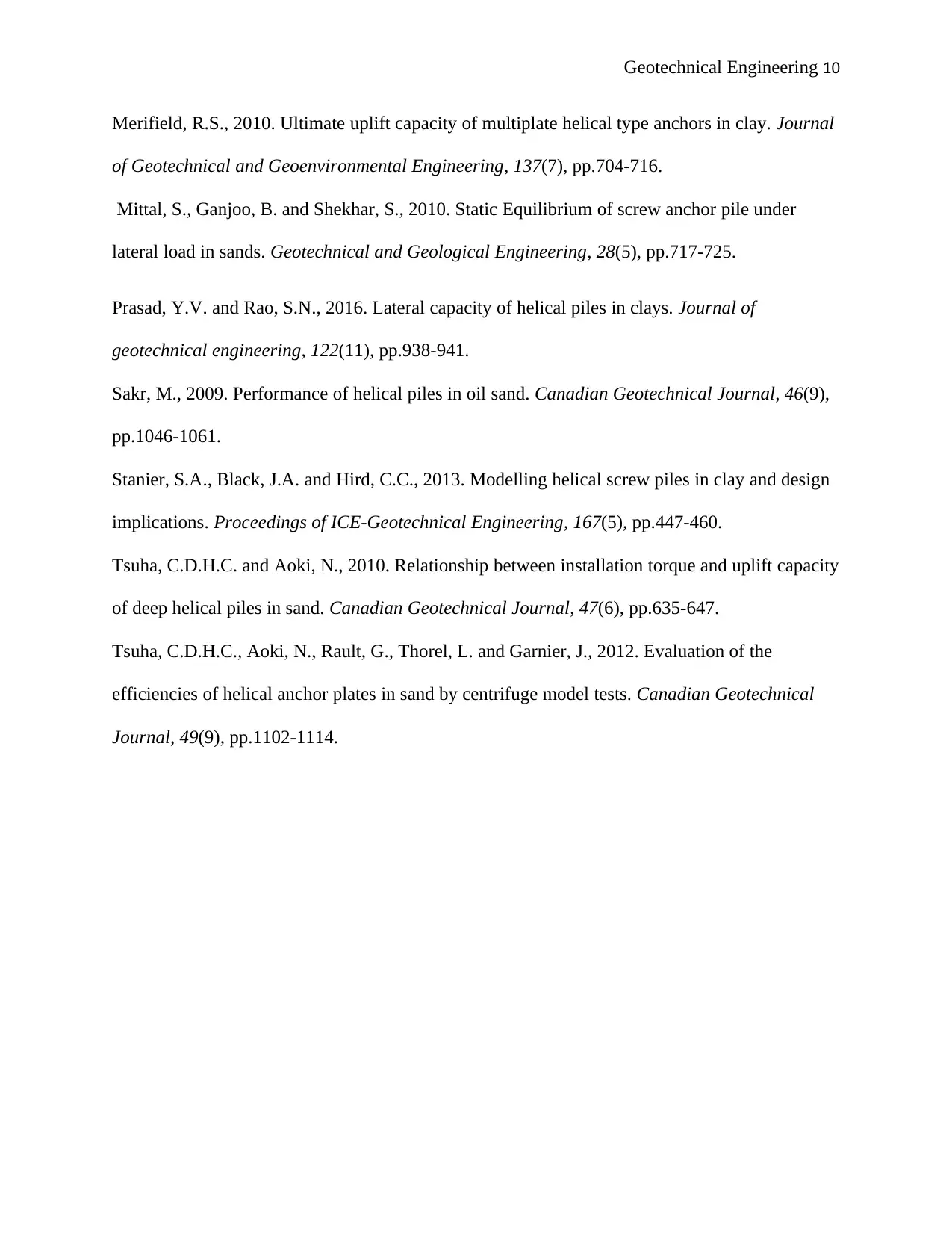
Geotechnical Engineering 10
Merifield, R.S., 2010. Ultimate uplift capacity of multiplate helical type anchors in clay. Journal
of Geotechnical and Geoenvironmental Engineering, 137(7), pp.704-716.
Mittal, S., Ganjoo, B. and Shekhar, S., 2010. Static Equilibrium of screw anchor pile under
lateral load in sands. Geotechnical and Geological Engineering, 28(5), pp.717-725.
Prasad, Y.V. and Rao, S.N., 2016. Lateral capacity of helical piles in clays. Journal of
geotechnical engineering, 122(11), pp.938-941.
Sakr, M., 2009. Performance of helical piles in oil sand. Canadian Geotechnical Journal, 46(9),
pp.1046-1061.
Stanier, S.A., Black, J.A. and Hird, C.C., 2013. Modelling helical screw piles in clay and design
implications. Proceedings of ICE-Geotechnical Engineering, 167(5), pp.447-460.
Tsuha, C.D.H.C. and Aoki, N., 2010. Relationship between installation torque and uplift capacity
of deep helical piles in sand. Canadian Geotechnical Journal, 47(6), pp.635-647.
Tsuha, C.D.H.C., Aoki, N., Rault, G., Thorel, L. and Garnier, J., 2012. Evaluation of the
efficiencies of helical anchor plates in sand by centrifuge model tests. Canadian Geotechnical
Journal, 49(9), pp.1102-1114.
Merifield, R.S., 2010. Ultimate uplift capacity of multiplate helical type anchors in clay. Journal
of Geotechnical and Geoenvironmental Engineering, 137(7), pp.704-716.
Mittal, S., Ganjoo, B. and Shekhar, S., 2010. Static Equilibrium of screw anchor pile under
lateral load in sands. Geotechnical and Geological Engineering, 28(5), pp.717-725.
Prasad, Y.V. and Rao, S.N., 2016. Lateral capacity of helical piles in clays. Journal of
geotechnical engineering, 122(11), pp.938-941.
Sakr, M., 2009. Performance of helical piles in oil sand. Canadian Geotechnical Journal, 46(9),
pp.1046-1061.
Stanier, S.A., Black, J.A. and Hird, C.C., 2013. Modelling helical screw piles in clay and design
implications. Proceedings of ICE-Geotechnical Engineering, 167(5), pp.447-460.
Tsuha, C.D.H.C. and Aoki, N., 2010. Relationship between installation torque and uplift capacity
of deep helical piles in sand. Canadian Geotechnical Journal, 47(6), pp.635-647.
Tsuha, C.D.H.C., Aoki, N., Rault, G., Thorel, L. and Garnier, J., 2012. Evaluation of the
efficiencies of helical anchor plates in sand by centrifuge model tests. Canadian Geotechnical
Journal, 49(9), pp.1102-1114.
1 out of 10
Related Documents
Your All-in-One AI-Powered Toolkit for Academic Success.
+13062052269
info@desklib.com
Available 24*7 on WhatsApp / Email
![[object Object]](/_next/static/media/star-bottom.7253800d.svg)
Unlock your academic potential
© 2024 | Zucol Services PVT LTD | All rights reserved.




